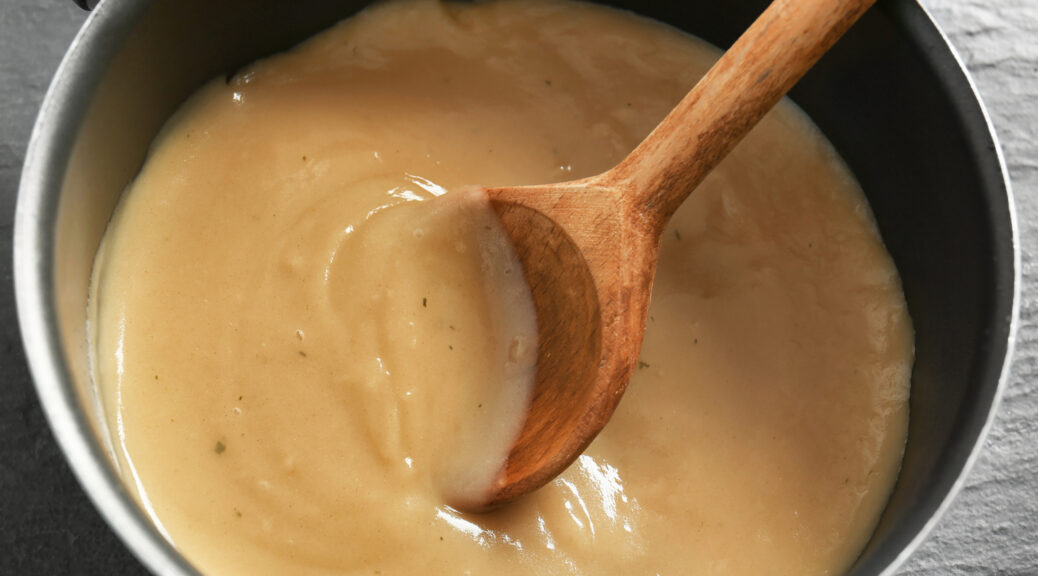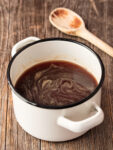
Make Homemade Gravy; With Meat or Without
Gravy is traditionally a sauce made from meat drippings and combined with some type of thickening agent. It was especially used in French cooking and became popular in the U.S. in the 1800s. Gravies other than those made from meat include cream or white gravy, mushroom gravy, onion gravy, giblet gravy, vegetable gravy, and more.
INFORMATION BELOW FROM 1800s COOKBOOKS
MAKING GRAVIES
Never toss “that carcass” of fowl, or the ham, or mutton-bone, “with next to nothing upon it,” to the dogs, or into the scavenger’s barrel. Seasoned and thickened, it will be useful as gravy in many ways, always remembering that it must be skimmed before it is used.
All bits of tough skin, gristly portions, soft bones, and cartilage should be removed before cooking from roasts, chops, and steaks, when it can be done without injuring the shape of the meat. These scraps can be used for gravies.
If you buy meat for gravy—which you need not do very often, get the coarser pieces and marrow-bones pounded to bits. Cut up the meat fine, also. You cannot extract the strength so completely from a solid “chunk” of flesh as from the same quantity shred into strips or cut into dice.
If there is any fear of meat for gravy being spoiled before it be wanted, it should be well seasoned and lightly fried, to keep it a day or two longer. But the gravy is best when the juices are fresh.
Gravies are also much better when the meat is laid in the bottom of the pan and stewed with herbs, roots, and butter, than when water is put to the meat at first. The gravy that is drawn from the meat should almost be dried up before the water is added. Potato water, when used in making gravies, greatly improves the flavor.
For the first hour, it should barely simmer. After that, stew very slowly and steadily until the liquid is reduced to one-half of the original quantity. If gravies are too weak, do not cover them when cooking, so that the watery particles may evaporate. The best gravy is like jelly when cold.
Gravies are best made the day before they are wanted and should never be kept in any kind of metal.
TO KEEP GRAVY
When gravies are to be put by, let them be changed every day into fresh scalded pans. Whatever liquor has vegetables boiled in it is apt to turn sour much sooner than the juices of meat.
To draw gravy that will keep for a week, cut some lean beef thin, put it into a frying pan without any butter, cover it up, and set it on the fire, taking care that it does not burn. Keep it on the fire till all the gravy that comes out of the meat is absorbed, then add as much water as will cover the meat, and keep it stewing. Put in some herbs, onions, spice, and a piece of lean ham. Let it simmer till it is quite rich, and keep it in a cool place; but do not remove the fat till the gravy is to be used.
TO BROWN FLOUR
Spread some fine flour on a plate and set it in the oven, stirring it frequently that it may brown equally all through. Put it into a jar, cover it well, and keep it to stir into gravies to thicken and color them.
BROWN GRAVY
Put two ounces of butter into a stew-pan, throw in two large onions cut in rings, and fry them a light brown. Then add two pounds of shin of beef and two small slices of lean bacon (if at hand), which should be cut into small square pieces. Add three cloves, season with salt and whole pepper to taste, and pour in a teacup* of water. Let it boil for about ten minutes, or until it is of a nice brown color, occasionally stirring the contents.
Now fill up the pan with two quarts of water, let it boil up, then draw it to the side of the fire to simmer very gently for one and one-half hours. Strain, and when cold, take off all the fat. In thickening this gravy, melt three ounces of butter in a stew-pan, add two ounces of browned flour, and stir till of a light-brown color. When cold, add it to the strained gravy, and boil it up quickly.
*teacup – same as a jill or gill; four ounces in the U.S. and five ounces in the U.K.
GRAVY FOR FOWL
Wash the feet of the fowl nicely, and cut them and the neck into small pieces. Simmer them with a little bread browned, a slice of onion, a sprig of parsley and thyme, some salt and pepper, and the liver and gizzard, in a pint of water, till the liquor is half reduced. Take out the liver, bruise it, and strain the liquor into it. Then thicken it with browned flour and butter. A teaspoon of mushroom ketchup will make the gravy very good.
GIBLET GRAVY
Mince the giblets* fine and brown in two tablespoons of bacon fat, adding two tablespoons of flour. After browning, add one quart of water. Cook slowly while the fowl is roasting. Rub the gravy through a sieve, then return to the fire and bring to a boil. It is then ready to serve.
*giblets – the liver, heart, gizzard, and neck of a chicken or other fowl, often used to make gravy, stuffing, or soup. In the past, the head and feet were also considered giblets.
GRAVY WITHOUT MEAT
Put into a basin a glass of beer, a glass of water, some pepper and salt, grated lemon peel, a bruised clove or two, and a spoon of mushroom ketchup. Slice an onion, then flour and fry it in a piece of butter till it is brown. Turn all the above into a small pan and simmer it covered for twenty minutes. Strain it off for use, and when cold, take off the fat.
MILK GRAVY
Blend two tablespoons browned flour with cold water or milk, then stir into one pint boiling rich milk (part cream). Stir until smooth and add salt.
CREAM OF LENTIL GRAVY
For rice, macaroni or cutlets of corn meal porridge.
1 cup mashed lentils
1 cup rich milk or thin cream
1 teaspoon flour
Salt
Thicken milk with flour blended with water and combine with lentils; heat. Add finely-sliced celery and chopped parsley for some dishes.
VEGETABLE GRAVY
Three tablespoons chopped onion
Three tablespoons finely-slice celery
Two tablespoons grated carrot
One clove garlic, crushed
One large bay leaf
Five tablespoons oil
Five tablespoons white flour
Two teaspoons browned flour
One-half cup strained tomato
Three and one-half cups boiling water
A trifle of thyme
Salt
One tablespoon chopped parsley
Simmer vegetables and bay leaf in oil for ten minutes. Do not brown. Add brown and white flour, tomato and water, and boil. Remove bay leaf, add salt, thyme and parsley and serve. Celery tops may be used instead of sliced stalks. The gravy may be strained.
Image from Deposit Photos
=================================================
Do You Ever Make Your Own Gravy? Please Leave a Comment Below.
=================================================

6 thoughts on “Make Homemade Gravy; With Meat or Without”
I’m 80 years young and find making good gravy a daunting task.
To me, making gravy which I consider a comfort food is a perfect topping.
So may I suggest we get busy and stop being lazy and enjoy the works of our hearts over a plate of spuds.
I like making my own meals from scratch. Sometimes I follow a recipe and sometimes improvise. A few don’t work out, but so far the failures have been edible. It seems like interest in cooking is growing.
I don’t make gravy much any more either but I sure do like it, especially biscuits and gravy, but I don’t eat biscuits much any more either. 🙁 Vegetable gravy sounds interesting. My husband would like that.
I love mashed potatoes and brown gravy. I never make it myself, but if I go to a buffet, I make sure to get some.
We never use gravy anymore except on Christmas, and we are never the ones to prepare the dinner since we have to drive a long way. I usually make turkey gravy in a skillet from the pan drippings if I make gravy at all.
My mother used to make gravy from pan drippings when I was young, but then went to a powdered mix.